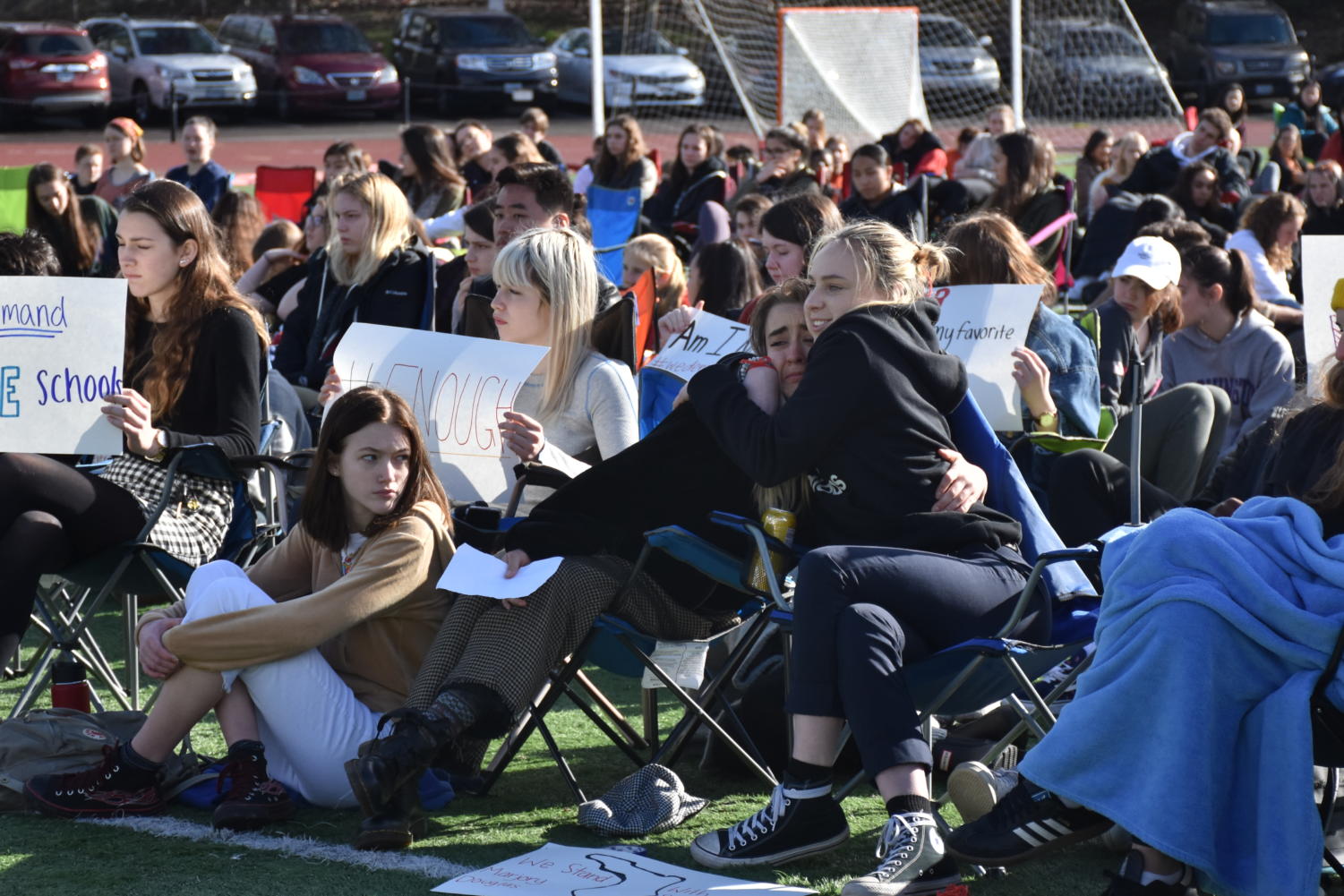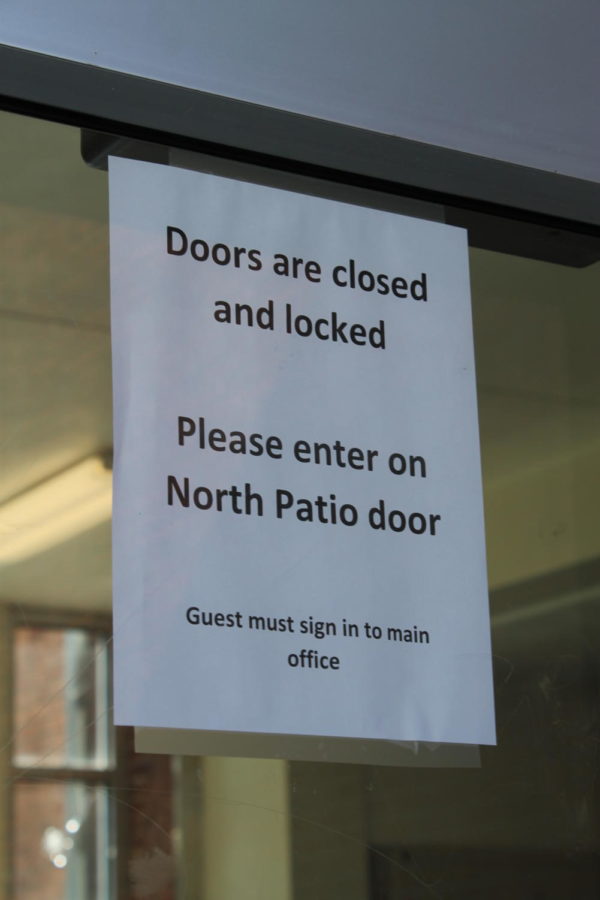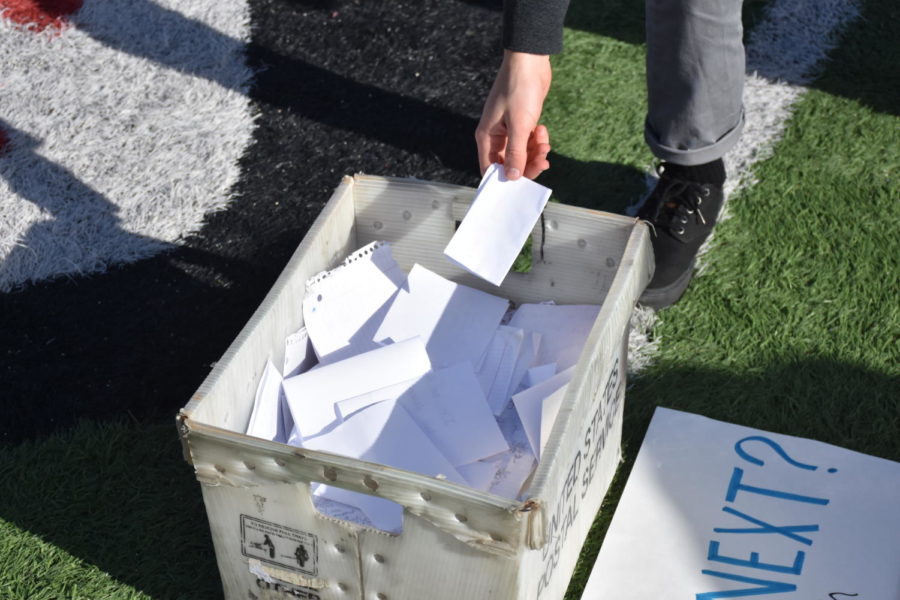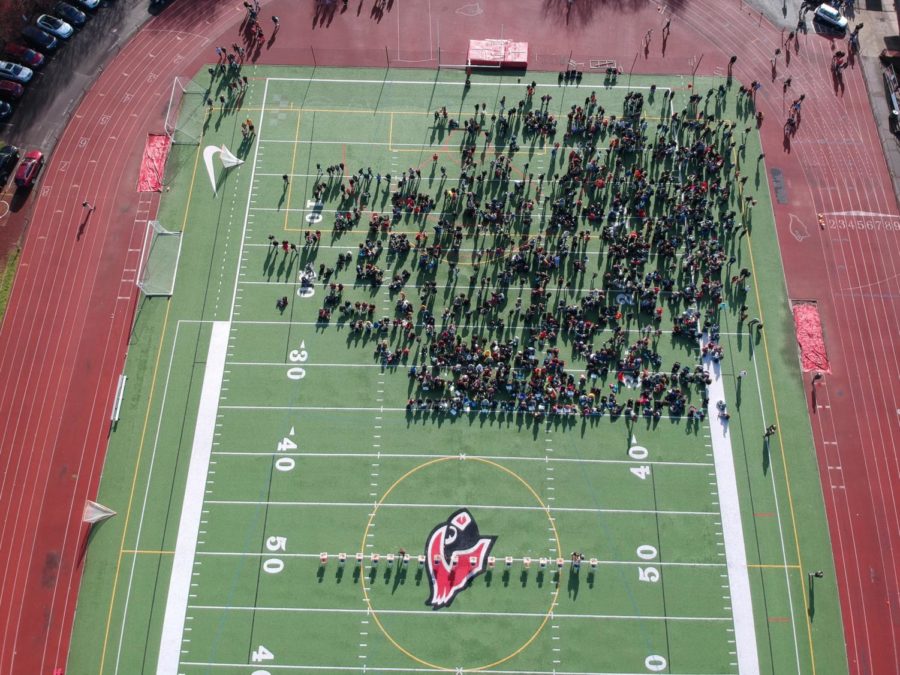Lincoln students talk gun control
This is a collection of stories written by Oscar Harold, Sage Taylor, Jack Forman, Armand Yazdani and Daniel Lewinsohn | Illustrations by Wyatt Lincoln and Oscar Harold | Photos by Jamie Bikales, Faith Pauken, Abani Neferkara and Sydney Laxson | Web Design by Sydney Laxson
April 2, 2018
All doors around Lincoln are now locked after the saftey concerns following the Parkland, Fl shooting at Majory Stoneman Douglas High School. Signs direct students and guest to the main doors.
Despite the disagreement on the national level about gun control, many Lincoln students agree that changes need to be made, both within the school and in the legislature.
“I definitely think something needs to be changed. We shouldn’t have to be in this situation where we’re worried about someone shooting up our school,” said sophomore Liem Mackenzie.
One safety precaution Lincoln has recently implemented is locking all of the doors after starts in the morning.
“I think that locking the doors is a good idea,” said sophomore Michael Riley.
Though Riley’s family owns guns, “we use them for skeet shooting, but it’s more of a family bonding thing [more] than anything.” He “also think[s] that there should for sure be harsher regulations on buying guns,” he said.
When examining the national conversation of gun control, the National Rifle Association is inseparable from the topic.
The NRA is a tax exempt organization used as a pool of money and resources to organize activities, lobby Congress and act in the interest of gun owners across America. More than a quarter of America’s population owns guns, according to the General Social Survey by Gallop in 2013.
The NRA’s mission statement is, “To protect and defend the Constitution of the United States, especially with reference to the inalienable right of the individual American citizen guaranteed by such Constitution to acquire, possess, collect, exhibit, transport, carry, transfer ownership of, and enjoy the right to use arms,” according to its website.
People have many different reasons for owning guns: some use it for family bonding, some use it for survival in rural areas and some people us it as self-defense.
The go-to rebuttal for gun rights defenders is the Second Amendment of the U.S. Constitution. Adopted in 1791, the Second Amendment reads, “a well regulated militia being necessary to the security of a free state, the right of the people to keep and bear arms shall not be infringed.”
There are often debates about whether the Second Amendment is still relevant in modern times. One thing’s for sure: America’s gun culture runs deep.
Many students feel helpless when faced with an issue so large and complex, but others have already started to take action.
At Lincoln, a student-led club named The Never Again Club has already started planning walkouts and leading discussions among students on gun control.
“As students, we should be motivated to make Lincoln as safe as possible. We should understand what to do in the case of a school shooting. We should also be actively fighting for more Oregon gun regulations because they are not keeping us safe,” says junior Laney Hergenhan.
The Oregon Legislature has already started to make changes to gun laws after the hellfire of marches and protests led by primarily students that have consumed many of our nation’s largest cities. According to OPB, on March 5, Oregon Governor Kate Brown signed a bill prohibiting domestic abusers and anyone with a restraining order from purchasing a weapon.
Although it’s a small change, it’s definitely a step in the right direction towards making our schools and communities safer.
Students walked out on March 14 to protest lack of action on school shootings. Students drafted letters and drawings to be sent to the families in Parkland, Florida
Students lead the national discussion on gun reform
Across the nation at 10 am on March 14th, America saw a new type of activism. America saw peaceful student activists lead demonstrations comprised of all ages, genders, races and ethnicities, uniting for school safety.
Demonstrations ranged from walkouts to memorials. At Lincoln, student organizers opted for a tribute for the victims of Parkland at Marjory Stoneman Douglas High School who were massacred on Feb 14, 2018. The March 14 demonstrations were designed to show solidarity with the Parkland community.
Governor Kate Brown and Superintendent Guadalupe Guerrero attended the Roosevelt High School demonstration, and Portland Mayor Ted Wheeler made an unexpected appearance at the Lincoln tribute.
At Lincoln, students gathered on the field facing 17 desks laden with flowers. Each desk was labeled with name of a victim. Starting at 10 am, a moment of silence was held for 17 minutes, one minute for each person killed.
Many students were overcome with emotion, including Katie Swigart, a senior.
“I didn’t expect to be emotional because I’m not an emotional person but then I saw those desks, the desks that I sit in, my friends sit in and my sister sits in,” said Swigart.
At the end of the 17 minutes, students were encouraged to write letters to the community of Parkland as the song “Lean on Me” played over the loudspeakers.
“We are sending all the letters to Florida so Parkland knows that we support them,” said Hanisi Accetta, the leadership teacher who helped organize the tribute.
The March 14th memorial was organized by the Never Again Club, a club that wants to raise awareness about school shooting and gun control reform.The club acts as an umbrella for student activism for gun control at Lincoln.
The club’s structure is separated into different categories: legislative action and student and media outreach. Faith Pauken heads the club as president. At the end of the protest, Pauken had one impression of the demonstration: “wow.”
“I didn’t expect any of this! I didn’t expect it to go so well! I didn’t expect everyone to be silent. I didn’t expect it to be sunny outside,” said Pauken. “This was a huge encouragement.”
When asked about the students who chose not to demonstrate, Pauken said that she “completely respects their opinion” and that she “wants to be welcoming as possible for all students.”
Although many demonstrations have already taken place, many are yet to come. On April 20th, student activists across the country will protest on the 19th anniversary of the Columbine school shooting, a shooting that rocked America.
Gabby Cosey, a student leader in the Never Again club, is helping to organize busing to Salem for a town hall with politicians on the 20th through the help of organizations the Bus Project and Mom’s Demand Action for Gun Sense in America.
“We want to bus everyone who wants to go to Salem,” said Cosey.
If students want to get involved in the town hall, Cosey said to “talk to myself, Madeline [Gochee] or Carmen [Vintro] because we are organizing workshops for the town hall in Salem where students can learn about evidence, facts, and messages.”
If students wish to stay in Portland, Cosey said that there will be a few student leaders, including Pauken, who will lead a walkout.
So far, over 1600 walkouts have been registered through the National School Walkout Campaign.
On March 15th, Portland Public Schools released an online statement in support of the movement.
“We are proud of our students. Please know we stand with you. Your voice is powerful, and you are right to expect action if we are ever going to guarantee safe and supportive schools,” said the statement.
For students who do choose to demonstrate outside the classroom on April 20th, Pauken has one word of advice: communication. “Talk to your teachers and explain what this issue means to you,” said Pauken,“communication is key.”
Students’ concerns over their safety
After President Trump called for all teachers being armed in schools following the school shooting in Parkland, FL, the Cardinal Times asked staff for their opinions.
Since the Parkland, Florida shooting, the “Never Again” movement has blown up across the country. The students of Marjory Stoneman Douglas have spoken out on gun reform to government officials, national news channels and many more. These students have inspired millions of other young adults around the world to speak up.
The recent shootings in Florida and elsewhere have brought up an issue many students are asking: is my school safe?
Lincoln, being an urban public high school, leads some to believe that it is vulnerable to a school shooting. The Cardinal Times interviewed some students about their opinions on how safe they feel in school.
“I was scared to come to school [after the Florida shooting]. I was afraid that the same thing would happen here,” says junior Asher Wheeler.
Junior Madison Fassiotto says, “I don’t think you can ever be too prepared or too naive.”
One recent change has been the majority of entrance doors of Lincoln being locked during the day, preventing people from outside coming in. The doors used to be unlocked throughout the school day. This made it very easy for students to walk in and out of the school. However, after the Parkland shooting, administrators began to lock the doors from the outside. This led to a variety of student opinions.
“At some points it comes to the point of it being a prison,” says junior Brandon Hendren.
“I think instead, we should invest in personnel, like another [campus security officer like Stan] Caples, rather than locking the doors,” says junior Caleb Kono.
Other students agree with the move. “It’s such a small inconvenience that I think we can handle it,” says junior Abby Calhoun.
“It’s such a small thing that we can deal with and it is for [our] own safety,” states junior Kiana Gellman.
Locking the doors could prevent an unauthorized person from coming into the school, but there are still things Lincoln can do to ensure that every student is prepared for any type of conflict.
Junior Daniella Vick says, “We should be taking lockdowns seriously. We had [so many] fire alarms in one day and people are laughing about it. We need to take these things seriously. People aren’t taking the safety into consideration during the drills.”
“In the short term, I think we need to be educating people about the mindset is what we need to be doing,” Vick adds.
Junior and co-leader of the Never Again club, Gabby Cosey wonders why there isn’t more security around campus.
“How many urban schools don’t have metal detectors? Not many,” she says.
Students gather on the field to pay respect for the 17 students who lost their lives in Parkland, Florida on March 14.
Faculty consider bearing arms to protect students
President Donald Trump’s proposal to arm teachers has been met by both criticism and approval. His backers state that armed teachers can more effectively protect students especially if trained. Critics of the plan argue that teachers are educators who are unobligated to risk their lives or to kill.
Trump’s proposal revived a national debate. Following the Sandy Hook Elementary School shooting in 2012, the National Rifle Association similarly advanced the idea of arming teachers.
Discussion on arming teachers has pervaded Lincoln following the president’s remarks. Teachers and other staff have also considered the efficacy of his idea.
The Cardinal Times investigates how the school’s personnel regard the proposal to arm teachers.
Political Economics teacher David Bailey says that he “doesn’t have a problem with teachers being armed.”
“As a general position, I would not have a problem with teachers properly trained to be designated as weapon carriers in the building,” Bailey says.
He would prefer to remain unarmed, because he “would not care to go to the training.”
Bailey adds that he “would not take away [the opportunity to bear arms] from any other staff members who would be willing to go through training.”
“When I say staff members, I’m not just talking teachers, but campus monitors and people we could bring in and people from outside,” he says.
However, the history teacher believes that “it would be absurd” if teachers were to publicly display their guns, such as in holsters.
“Any adults in school, who would be trained and authorized to carry a concealed weapon should be kept secret to the larger staff. I don’t want to know who’s carrying it,” Bailey says.
He questions whether “any of this is truly necessary, given the rarity of school shootings” in spite of “how horrible they are.”
Bailey adds that additional armed security to Lincoln would not be unusual.
He noted that an armed policeman has been assigned to Lincoln for several years, and he’s y never heard anyone complain. He says that sometimes two or three police officers have been present at football and basketball games every week in the fall and winter.
Attendees at the State boys’ basketball tournament last week, Bailey recalls, were checked for metal objects as they passed armed security before entering the audience.
“Members of Congress have very tight security. I don’t think people at the Oscars felt unsafe because there were armed guards,” he notes.
Bailey states that armed guards accompanied representatives and senators who spoke at the DC student protest on March 14.
“Indeed, The Capitol is an armed camp,” he says.
Principal Peyton Chapman opposes the possession of guns in general.
“I don’t think guns should be in schools, I don’t think they should be in individuals’ homes. Certainly not when children are present,” she stresses.
Chapman is “worried about having all these guns in schools.”
“I wouldn’t want to increase the risk of accidental shootings [or increase] the risk of teachers with self-harm,” Chapman says.
She alludes to Dalton High School teacher Randall Davidson, 53, who barricaded himself in an empty classroom before firing his pistol. No one was hurt.
“Teachers get into teaching because they love children and because they love their subject matter,” the Chapman adds.
She notes that teachers already have too much on their plates.
“Just trying to be masters of their content, and build relationships with their [students] is hard enough.”
Chapman believes that arming teachers will breach the peace at Lincoln.
“Everything we preach and teach about schools is [about] creating a safe and inclusive and warm and inviting environment. Gun toting teachers is the opposite of that,” she explains.
“The whole concept [of arming teachers] is surreal.” Chapman adds, “there would be more guns fired, more bullets harming people.”
In sum, the principal fears that the armament of teachers “would be mayhem.”
“How does a trusting, welcoming school build a relationship with a student, with a gun?” she inquires.
Ethics and English teacher Gabrielle Buvinger-Wild argues that firearms should be “out of the schools.”
“I don’t think that harming children is in the job description of being a teacher,” she clarifies.
Buvinger-Wild adds that “owning a gun statistically increases one’s risk of being shot.”
She clarifies that it “is not uncommon for people to be shot with guns that they own for reasons of self defense.”
She posits that weapon carriers “might feel emboldened to enter dangerous situations” which they would avoid unarmed.
She explains that policemen may struggle to search for a gunman with teachers armed.
“[Law enforcement] is looking for a person to subdue, and if you have 30 people with a gun, it would make their job a lot more difficult,” the teacher says.
Buvinger-Wild believes teachers would most likely be equipped with sidearms, if they were to be armed, which would not be “an adequate force” against the school shooter’s weapons.
She imagines that many other problems could arise if teachers were to be armed.
“I can very easily see a teacher targeting a student of color [during a school shooting] because of implicit bias,” the teacher states.
She also worries that if a teacher were to fire at an armed student, “they could miss and hit another student.”
English teacher Amanda Jane Elliott agrees.
“I think [arming teachers] is probably the stupidest idea I ever heard of,” she says.
During the Parkland High School shooting, Broward Deputy Scot Peterson neglected to enter the building for four minutes.
When asked if teachers would react similarly to Peterson, Elliott responded in the affirmative.
“Yeah, because we would have been asked to shoot someone we know. Not random people,” she says.
“If [English] police officers can live and do their jobs without guns, teachers can live and do their jobs without guns,” the England-born teacher adds. Most police officers in England are unarmed.
Elliott bears one question when it comes to trained-armed teachers.
“You train these ninja warrior teachers, but [where do they put guns]? Is it in a drawer? Is it in a safe?” she asks.
The English citizen is unable to fathom why individuals buy Armalite guns such as the AR-15 in the United States.
“It’s mind boggling. My friends in England will say ‘what’s going on?’ I’ll say ‘I don’t know. I don’t know.’”
Elliott fears that arming teachers would elicit a bleak outcome.
“We don’t need a room of 30 teenagers and a gun,” she asserts.
The very idea of firing at a student jars her.
“How the hell are you going to say ‘shoot someone else’s kid?’” she asks.
Graphic by Wyatt Lincoln and Oscar Harold
Statistics gathered from, New York Times, report by Education Week and Every Town Research
Editorial: Lawmakers must act on gun violence
The Parkland Shooting on Feb. 14 sparked national debate around gun violence prevention, with Republicans calling for increases in mental health treatment and Democrats demanding increased background checks and more gun control.
While the debate continues to rage on, and students walk out across the country, nothing has been done on a national level. Over a month after the shooting and Congress has failed to pass a single gun related bill despite constant pressure from their constituents.
Similarly to countless other school shootings, the public outcry has been met with an utter lack of action on the national level.
According to research conducted by the World Bank, the United States accounts for 46 percent of the population in developed countries, but over 80 percent of deaths caused by guns. Additionally, their research found that the gun homicide rate in the US was 25.2 times higher than the other developed countries.
This difference may be partially due to the 1996 spending bill that forbade the Centers for Diseases Control and Prevention from “advocat[ing] or promot[ing] gun control.”
“The CDC felt that they were under threat from Congress, that their other funding for other issues would be cut if they continued gun prevention research,” says former CDC researcher, Dr. Jim Gaudino. He adds that this decision trickled down to the states, resulting in a massive lack of gun prevention research.
Dr. Gaudino suggests that gun violence can be treated as a matter of public health.
“Public health is about early prevention, if we can prevent something like heart disease, then we don’t have to deal with the consequences and costs,” he says.
By passing a bill that would reinstate the CDC funding for gun control, Congress would take the first step towards actually taking action and preventing further mass shootings.
While research on gun violence will prevent shootings in the long-term, laws must be passed now to limit the amount gun deaths currently plaguing the nation. Both sides agree that something needs to be done to help prevent gun violence.
A common proposal from Democrats is to pass so called “common sense” gun laws. These include in depth, required background checks, increasing the minimum age to buy guns, and lowering the capacity of legally acquired magazines.
Recent studies support the proposal to increase background checks.
A study conducted by Kara E. Rudolph on the implementation of the handgun purchaser licensing law in Connecticut found a 40% decrease in firearm homicides.
Additionally, a study done by Daniel Webster on the reduction of a similar law in Missouri found a 25% increase in firearm homicides after the law was repealed.
Given this information, it is clear that Congress must take action to pass a law that requires in depth background checks.
Another aspect of gun violence prevention that many Republicans support is a focus on mental health issues. Many believe this could help tackle the issue.
Junior Ashok Kaushik believes Congress should “increase funding for things such as mental health assistance to attack the roots of the problem.”
While this might help fight the problem, it is not the only solution. An analysis of all 235 mass killings found that only 22% of the shooters could be considered mentally ill.
Many people have their own ideas about what causes the shootings and how we can prevent them.
School Resource Officer Stoffel believes “the most healthy thing a person can have is loving parents, I think that’s the answer to most of society’s problems.”
In the meantime, he thinks increasing the amount of Student Resource Officers in each school could help ensure the safety.
While there is no clear solution to the gun violence that plagues our society, several steps must be taken to begin the process of healing. CDC funding must be increased and bipartisan bills must be passed that include gun control measures from both Republicans and Democrats. If nothing is done, the same cycle of loss of life and inaction will continue.






Keenon Daequan Williams • May 10, 2018 at 3:06 pm
Hey, I just wanna thank you fo’ suppotin’ dis movement! Us homies always support oua backs, man! AM I RIGHT?! BICK BACK AND BE BOOL!
FO HUNNID.